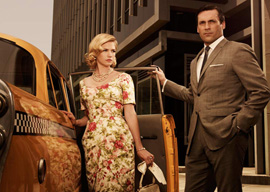
August 26, 2011

January Jones and Jon Hamm
Second, gender specificity. In those far-off days, men had short hair, wore natty clothes, held the door for ladies, and smoked pipes (cigars and cigarettes, too, but the pipe was considered über-masculine). Women tended to wear big hair such as bouffants or beehives. (The latter was almost singlehandedly revived in our time by the late Amy Winehouse.) And they walked. Oh, did they walk! Few women today can manage the particular hip movement that so clearly differentiated the female from the male, but it was something to watch. For the most part, gender roles were clearly defined from childhood: Men were soldiers, sailors, ad executives, and businessmen. Women were wives, secretaries, and teachers. Little girls did not play football, and little boys only played dolls with G.I. Joe. Here too, the portrayal of such stuff on the little screen has a strange attraction for those who have been raised with unisex fashions and lifestyles and expect a girl to “put out” on the first date.
Third, well, fun. People smoked and drank. A lot. A real lot. I can remember watching the cigarette smoke fill movie theaters. The purse-lipped brigade had other fish to fry in those days, and for the most part they left the drunks and human chimneys alone. It might be objected that cirrhosis and lung cancer were more widespread in those days. Perhaps, but AIDS and herpes were unknown. It is, I think, this latter point that is the greatest draw for the era’s fans.
For those who wish they could travel in time back to Camelot outside their minds, Southern California boasts an enormous number of “time machines.” (It is no wonder that Mad Men, although set in New York, is filmed out here.) Despite the fact that so much of the social revolution that propelled us from that world to this occurred in California, it amazes me how many sanctuaries from that same revolution can be found here.
This nostalgic glow is to some degree over-idealized—and the modern mantra is that the era was sexist, racist, and homophobic. The surface tinsel of the Kennedys’ Camelot was just that—and the fact that social mores would collapse so quickly over the next decade shows how fragile they really were. Perhaps the era’s greatest crime was that it evolved into what followed it. Nor should it be forgotten that if our own time has a certain nostalgia for the early ’60s, that era had a nostalgia of its own—for the 1920s and 30s in such series as The Untouchables and The Roaring Twenties.
All of which points up two truths. On one hand, folk bemused by current problems always seek shelter in supposedly happier times. As a Victorian New Year’s poem put it, “For hope shall brighten days to come, And memory gild the past.” But on the other, our era really is so screwed-up that anyone remotely sane will look elsewhere. As Tolkien put it, “it is easy to debunk escapism; but notice that the ones who do so are usually the gaolers!”